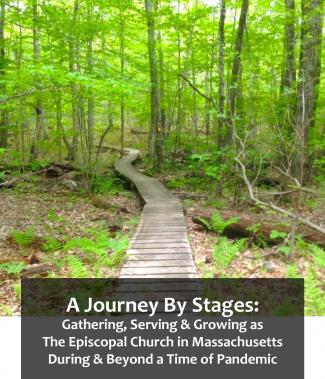As the phased reopening process progresses in the Commonwealth of Massachusetts amidst the still-prevalent COVID-19 pandemic, Episcopal congregations in Massachusetts have been operating under a bishops’ directive that there be no in-person public worship services until at least July 1.
As that date nears, Bishop Alan M. Gates and Bishop Gayle E. Harris of the Diocese of Massachusetts issued new guidance on June 15 that “strongly encourages” congregations to continue to refrain from holding in-person worship for now, but also permits congregations—in places where local conditions allow—to begin preparations for limited in-person regathering after July 1.
First, those congregations will need to complete a certification process “intended to help us be sure that our plans are comprehensive and safe,” the bishops said in their June 15 guidance (read it in full here).
A group of “regathering shepherds” has been recruited to work with congregations on their plans for “Stage Two” in-person gatherings, based on the “A Journey By Stages” guidelines issued jointly by both Massachusetts Episcopal dioceses in mid-May (in English here and in Spanish here).
In order to receive the bishops’ permission for in-person regathering after July 1, congregations, with an assigned regathering shepherd, will need to complete an online checklist attesting that they have a carefully considered regathering plan in place.
A similar process has been announced in the Diocese of Western Massachusetts.
The bishops’ June 15 guidance highlighted several principles that congregations need to consider, including the particulars of their context—“local coronavirus outbreak data; advisories by local community public health officials; architectural capacity and design of the church building; the ability of your staff and congregation to implement and maintain safety requirements; the prevalence of risk factors among your membership and your clergy and lay staff”—and it asks congregations to prioritize those who are most vulnerable.
“Many congregants and staff members with various risk factors will be advised or required to remain at home in order to stay safe. Others have unequal levels of access, both physically and technologically. Congregations should make inclusion and support of these members a key factor in all decisions about the timing and implementation of regathering,” the bishops said in their guidance.
They also noted that congregations need to be prepared to return to a more restricted phase of operations, should public health conditions worsen with new surges during the continuing pandemic, and that no congregation should feel pressure to regather prematurely.
“Our deepest hope is that our efforts to support one another in these decisions and preparations will indeed be manifestations of our love of God and one another,” the bishops said.
Learn more: The bishops' June 15 guidance letter is available here. The “A Journey By Stages” guidelines are available in English here and Spanish here. The supplemental Stage Two Regathering Checklist is available in English here and Spanish here.

